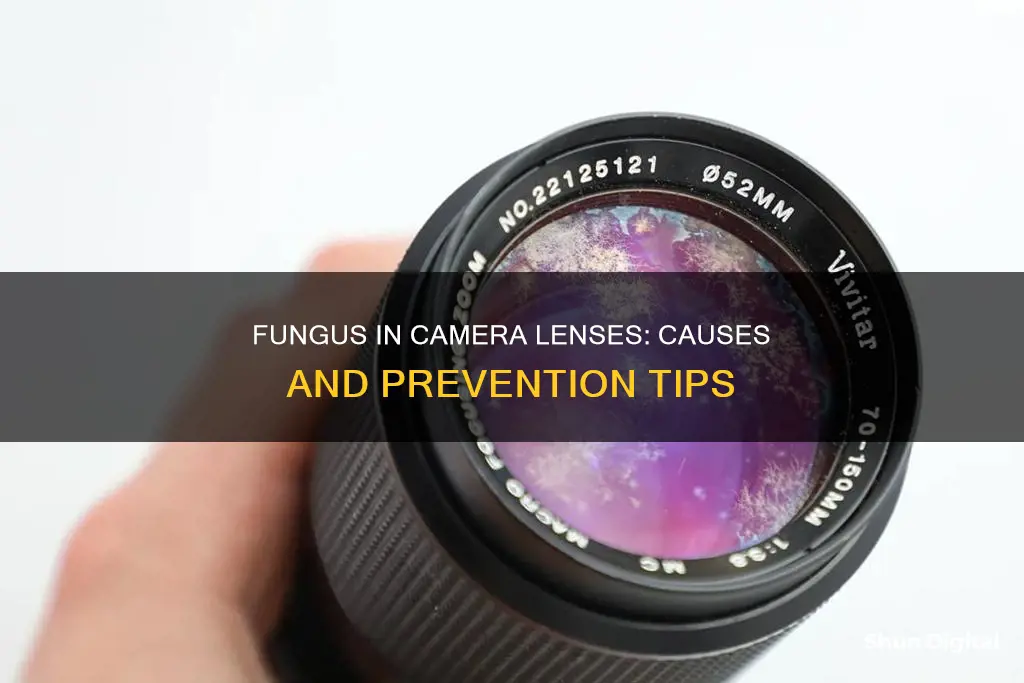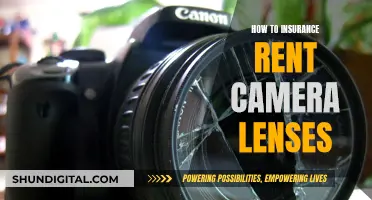
Camera lens fungus is a common issue for photographers, particularly those using vintage lenses. It occurs when dust containing fungus spores combines with moisture in the lens, leading to growth that can damage the lens and reduce image quality. While it may initially resemble flecks of dust, left untreated, lens fungus can cause permanent damage, including etching on the lens surface and a decrease in optical performance, resulting in fuzzy or hazy images.
What You'll Learn

Dust and moisture combine to cause fungus
Fungus thrives in dark and moist environments, so it is important to store lenses properly to prevent its growth. Lenses should be kept in cool, dry places and monitored for any signs of moisture or temperature changes. Storing lenses in a see-through or humidity-controlled cabinet with silica gel packets can help absorb moisture and prevent fungus growth.
Fungus can look like small web-like spots or patches inside the lens. If left untreated, it can permanently damage the lens, decrease its performance, and cause fuzzy or hazy images. To check for fungus, remove the lens from the camera and inspect both ends for any signs of growth. If fungus is suspected, a professional lens technician should evaluate the lens to determine if it can be cleaned.
While there is no guarantee that lenses will be completely free from fungus, taking preventative measures such as proper storage and monitoring environmental conditions can help reduce the likelihood of its occurrence.
Selling Camera Lenses: Tips for a Quick Sale
You may want to see also

Fungus thrives in dark and humid conditions
Camera lens fungus is a combination of dust and moisture that finds its way into the interior elements of a camera lens. It is not a problem caused by dust alone, but if the dust contains fungus spores and combines with moisture, then the fungus can grow and spread.
Fungus is spread by microscopic spores carried in the air. They are everywhere—on your clothes, in your food, and in the air you breathe. They are also often already present in the assembly room when a lens is being made. They can enter a lens through the slight bellows action of zooming and focusing, or through general use.
Fungus spores are inert until they find the right conditions to grow. They like darkness and moisture. This is why many vintage lenses survive—they are often exposed to light and dry conditions. However, if lenses are stored in dark and humid places, the spores can turn into something nasty like glass-eating fungus.
To prevent fungus growth, it is important to store lenses properly. Keep them in cool and dry places, and avoid leather and canvas bags, which are a great starting point for fungus as they are organic and often soak up moisture. It is also a good idea to periodically expose lenses to sunlight and dry air, as this keeps fungus at bay.
Refurbishing Camera Lenses: A Step-by-Step Guide to Restoring Optics
You may want to see also

Old lenses are more susceptible to fungus
Fungus thrives in dark and humid environments, and the real issue is how a lens is stored. Old lenses are more likely to have been stored in damp attics, cupboards, sheds, or garages—the worst places to keep vintage camera lenses.
Additionally, many older lenses used organic elements in their lubrication, which tend to vaporise over time and create the classic lens haze. This provides the perfect food source for the fungal spores.
Old lenses are also more likely to have been assembled in environments that were not sterile, such as factories or sheds, and may have been exposed to spores during the manufacturing process.
To prevent fungus growth, it is important to monitor the moisture and temperature of the storage environment and keep lenses in cool, dry, and well-ventilated places. Storing lenses in a see-through or humidity-controlled cabinet with silica gel packets can also help prevent fungus growth.
Cleaning Your Camera: Internal Lens Maintenance and Care
You may want to see also

Leather and fabric bags are bad for fungus prevention
Leather and fabric bags are not ideal for preventing fungus on camera lenses. The spores that cause fungus are present in the atmosphere and on our clothes, and they can easily get inside a camera lens. These spores are inert until they find the right growing conditions—darkness and moisture. Leather and fabric bags provide a great starting point for fungus as they are organic and often absorb moisture.
If you are using a leather or fabric bag to store your camera equipment, it is important to take extra precautions to prevent the growth of fungus. Avoid storing your equipment in the bag for long periods, especially if the bag is damp or humid. Always clean and dry your equipment after use, and store it in a cool, dry place when not in use. You can also use silica gel packets in your bag to absorb any moisture.
If you notice any signs of fungus in your bag, such as mould or a musty smell, it is best to discard it completely and invest in a new bag made of a different material. Canvas bags, for example, are breathable and less likely to trap moisture. Alternatively, you can store your equipment in a humidity-controlled cabinet or dry box to help prevent the growth of fungus.
Protecting Your Camera Lenses: Tips for Longevity
You may want to see also

UV light can kill fungus
UV light can be used to kill fungus in camera lenses. However, it is important to note that this method may not be completely effective in removing the fungus, as it is challenging to get enough UV light to penetrate the lens and reach the fungus. In addition, dead fungus will still remain on the lens, which can continue to degrade the optical quality. Therefore, it is recommended to also keep lenses dry and store them properly to prevent fungus growth.
Fungus forms in camera lenses when dust containing fungus spores combines with moisture. It is more common in lenses that are not weather-sealed and used in humid environments. The fungus can grow and spread, affecting the performance of the lens and causing images to appear fuzzy or hazy.
How to Prevent and Remove Fungus
To prevent fungus growth, it is important to monitor the moisture and temperature of the environment and store lenses in cool, dry places. Silica gel packets can also be used to absorb moisture. In addition, exposing lenses to sunlight or UV light can help kill fungus and prevent further growth. However, it is important to be cautious when using UV lamps, as certain types of UV light can be harmful to the eyes.
Alternative Options
If UV light treatment is not effective in removing the fungus, alternative options include selling the lenses or seeking professional lens fungus removal services. It is important to note that lens fungus removal can be complex and costly, and it may be more feasible to purchase a new lens.
Choosing Lenses for Your Mirrorless Camera: A Quick Guide
You may want to see also
Frequently asked questions
Lens fungus is a combination of dust and moisture that finds its way into the interior elements of a camera lens. Dust itself does not typically cause a problem, but if it contains fungus spores, and combines with moisture, fungus can grow.
Fungus can look like small web-like spots or patches inside the lens. It may also resemble tendrils, spider webs, hairs, or 'roots'. In some cases, it can appear as a clouding or haziness of the lens.
Fungal spores are present in the air and can easily enter a lens during use or when focusing. They may also be present on the lens from the time of manufacturing or enter through general use. Poor storage conditions, such as damp and dark places, provide an ideal environment for fungal growth.
To prevent lens fungus, keep your lenses in a cool, dry place, and avoid storing them in leather or canvas bags, which can retain moisture. Use silica gel packets to absorb moisture, and periodically expose your lenses to sunlight and dry air, as these conditions inhibit fungal growth.







